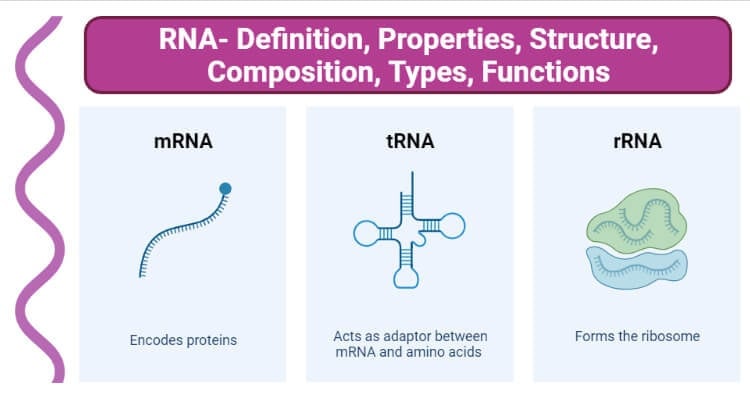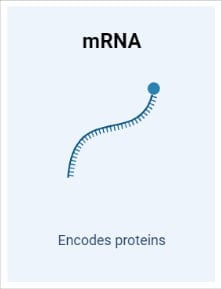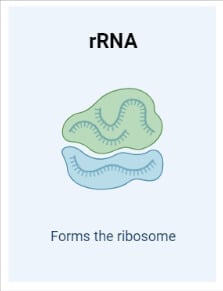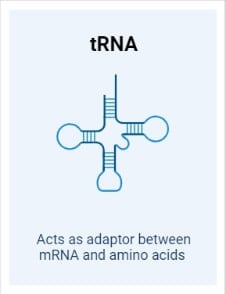RNA (Ribonucleic acid) is a single-stranded nucleic acid molecule and made up of ribonucleotides.
- A ribose nucleotide in the chain of RNA consists of a ribose sugar, phosphate group, and a base.
- In each ribose sugar, one of the four bases is added: Adenine (A), Guanine (G), Cytosine (C), and Uracil (U).
- The base is attached to a ribose sugar with the help of a phosphodiester bond. As RNA comprises many ribose nucleotides, the length of the chains of nucleotides can vary according to their types or their functions.
- RNA thus differs from DNA, on the type of sugar used to make the molecule and replacement of base Thymine in DNA with Uracil in RNA. Additionally, DNA is a double-stranded molecule whereas RNA is a single-stranded molecule.

Properties of RNA
- RNA is a single-stranded molecule and not a double helix, one of the consequences of this, is that RNA can form a variety of three-dimensional molecular complexes than DNA.
- RNA has ribose sugar in its nucleotides, rather than deoxyribose. These two sugars differ from each other in the presence or absence of an Oxygen atom.
- Ribose sugar is also a cyclical structure consisting of 5 Carbon and one Oxygen just like DNA. But the major difference is the presence of extra OH group in 2’ Carbon of ribose which is absent in deoxyribose sugar.
- The OH group in 2’ Carbon makes the RNA molecule prone to hydrolysis.
- Some studies have also concluded that this chemical liability of RNA due to extra OH- the group has led to DNA being the genetic storehouse as it lacks OH group in 2’Carbon making it more stable to hold information.
- RNA nucleotides carry the nitrogenous bases, Purines, and Pyrimidines. But in RNA in place of Pyrimidine Thymine, Uracil is present which too forms hydrogen bonding with Adenine just as Thymine does in DNA molecule.
Structure of RNA

- RNA is a typical single-stranded biopolymer of ribonucleotides bonded with each other via a phosphodiester bond.
- An RNA strand is synthesized in the 5’ to 3’ direction from a locally single-stranded region of DNA.
- It has ribose sugars that are attached to four bases: Adenine, Guanine, Uracil, and Cytosine. Ribose sugar has an extra OH- group in 2’ Carbon as compared to deoxyribose sugar in DNA.
- This extra OH- group in RNA, has led them to be synthesized for short-term functions.
- The three-dimensional structure of RNA is critical to its stability and function.
- RNA being a single-stranded molecule can form a complex structure by allowing its ribose sugars and bases to be modified on the action of cellular enzymes (that attach chemical groups), to perform different functions.
- They are even capable of folding on themselves and showing intramolecular hydrogen bonding between complementary strands, making it a double-stranded molecule to exhibit specific function.
Composition of RNA
- RNA is a biopolymer of nucleotides bonded with each other via a phosphodiester bond.
- The nucleotide that makes up the RNA are also referred to as Ribose nucleotide due to the presence of ribose sugar in their structure. Overall, RNA is composed of a ribose sugar, phosphate, and nitrogenous base.
- Ribose sugar is a cyclical structure made up of five carbons and one oxygen atom. This sugar contains two OH-groups at 2’ Carbon and 3’ Carbon.
- This ribose sugar is attached to a nitrogenous base via hydrogen bonding.
- There are four nitrogenous bases namely: Adenine (A), Guanine (G), Uracil (U), and Cytosine (C).
- These nitrogenous bases pair complementarily with each other: G with C and A with U.
Types of RNA
Of many types of RNA, the three well known and most commonly discussed and found in almost all organisms. These three types of RNA are:
- mRNA (messenger RNA)
- rRNA (ribosomal RNA)
- tRNA (transfer RNA)
1. mRNA (messenger RNA)

- It is a single-stranded RNA molecule that is complementary to one of the strands of DNA.
- mRNA is the version of the genetic materials that leave the nucleus and move to the cytoplasm where responsible proteins are synthesized.
- This RNA has utmost importance during protein synthesis, when the ribosome moves along this mRNA, it reads the base sequences and uses the genetic code to translate them into specific proteins.
- These codes are in the form of triplet sequences of nitrogenous bases and are often referred to as codons.
- As we now know that mRNA is responsible for transferring the genetic information into ribosomes where by reading the base sequences on mRNA, the translation of proteins is made possible, thus the name resembles its functions i.e., messenger RNA.
- We can even say mRNA is the molecule that uses genetic code present on a portion of DNA and make proteins. If mRNA wouldn’t have existed then the information on DNA could never be used by our body.
2. rRNA (ribosomal RNA)

- It is a single-stranded RNA molecule found in cells that forms the part of the protein-synthesizing organelle, Ribosome.
- It is synthesized inside the nucleus particularly in the nucleolus where rRNA coding genes are present. The synthesized rRNA can be of varying sizes, commonly distinguished as small and large.
- These newly synthesized rRNAs combine with ribosomal proteins and form smaller subunits and larger subunits of ribosomes respectively.
- These rRNAs are vital in recognizing conserved regions of incoming mRNAs and tRNA thus facilitating their binding and carrying out protein synthesis.
- Additionally, rRNA also has enzymatic activity (peptidyl transferase) and catalyzes the formation of the peptide bond in between two aligned proteins/amino acids during protein synthesis.
3. tRNA (transfer RNA)

- It is a type of RNA molecule that helps to decode information present in mRNA sequences into specific proteins.
- It is encoded by DNA in the cell nucleus and transcribed with the help of RNA polymerase ΙΙΙ.
- The structure of tRNA folds upon itself and creates an intra complementary base pairing which gives raise to hydrogen-bonded stems and associated loops that contains nucleotides with modified bases.
- The structure in two-dimensional resembles a cloverleaf having three loops and an open end. are usually 75-90 ribonucleotides in length.
- Each of these loops consisting of arms has a distinct name and function. The three-loop consisting arms are namely: DHU or D arm, which has recognition site for specific enzyme amino-acyl tRNA synthetase; T arm that consists of ribosome recognition site and Anticodon arm that recognizes and bind to mRNA present in the ribosome.
- The open end with no loop is the site for attachment of amino acid, via 3’ OH bonding with COOH- group of the amino acid.
- In general, tRNA reads the code on the mRNA sequence in Ribosome and translates specific amino acid, it does so along the length of the mRNA and gives out a polypeptide chain of amino acids (proteins) in association with other important enzymes like aminoacyl tRNA synthetase and peptidyl transferase.
Some other types of RNA
1. Ribozymes
- These types of RNAs refer to those RNAs that are capable of showing enzymatic activities.
- They were first discovered in introns of precursor ribosomal RNA of Tetrahymena thermophilus, where it was found that these noncoding sequences were capable of excising themselves without any protein or external source.
- These RNAs play vital roles in major reactions like RNA splicing, viral replication, and tRNA biosynthesis.
- rRNAs also show enzymatic activities and thus can be termed as Ribozymes.
2. Antisense RNAs
- Antisense RNAs are those RNAs that contain sequences that are complementary to protein-coding sequences of mRNA.
- These are single-stranded like mRNA but cannot code for proteins.
- However, they can interfere and inactivate their complementary mRNA sequences thus inhibiting protein synthesis.
- This ability of antisense RNAs has led researchers to create artificial antisense RNAs that can inhibit the protein synthesis of potential disease-causing organisms or of infected cells which then end up killing unwanted cells.
Functions of RNA
- The prime function of RNA is in protein synthesis.
- Without RNA, the information encoded in DNA could have never been transcribed to make essential proteins that a cell needs to maintain its integrity.
- mRNAs have now been widely used in pharmaceutical industries to synthesize potential vaccines.
- Moreover, mRNAs are now used to develop new categories of medicines
- mRNAs have made the formation of the cDNA library possible.
- rRNAs are structural units of Ribosomes, which are essential organelles during protein synthesis.
- Ribozymes can help suppress the expression of specific mRNA by cleaving them out without relying on the host’s machinery.
- Artificial antisense RNAs are capable of arresting protein synthesis by binding with the mRNAs, which have contributed to the human’s ability to combat diseases and mutations.
References
- N. Kyle Tanner, Ribozymes: the characteristics and properties of catalytic RNAs, FEMS Microbiology Reviews, Volume 23, Issue 3, June 1999, Pages 257–275, https://doi.org/10.1111/j.1574-6976.1999.tb00399.x
- Kirchner, S., Ignatova, Z. Emerging roles of tRNA in adaptive translation, signaling dynamics and disease. Nat Rev Genet 16, 98–112 (2015). https://doi.org/10.1038/nrg3861
- Griffiths AJF, Miller JH, Suzuki DT, et al. An Introduction to Genetic Analysis. 7th edition. New York: W. H. Freeman; 2000. Properties of RNA. Available from: https://www.ncbi.nlm.nih.gov/books/NBK21880/
- https://www.umassmed.edu/rti/biology/what-is-rna/
- https://courses.lumenlearning.com/microbiology/chapter/structure-and-function-of-rna/
- https://www.britannica.com/science/RNA
- https://www.genome.gov/genetics-glossary/RNA-Ribonucleic-Acid
- https://www.nature.com/scitable/topicpage/chemical-structure-of-rna-348/
- https://byjus.com/biology/structure-of-rna/
- https://earth.callutheran.edu/Academic_Programs/Departments/BioDev/omm/jsmolnew/trna/trna.html
- https://www.modernatx.com/mrna-technology/science-and-fundamentals-mrna-technology
